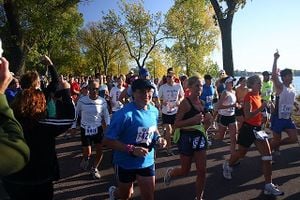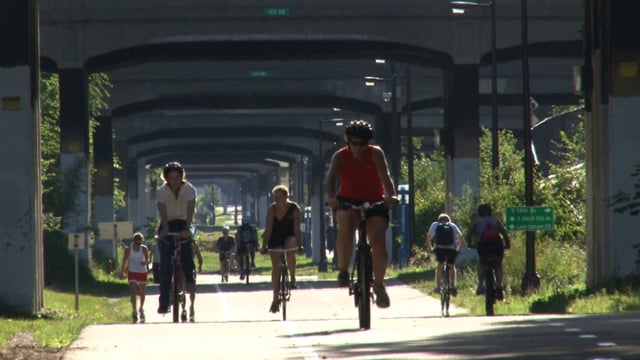The aim of this page is to recognise, celebrate and encourage the self-empowerment of community action networks (CANs) and community groups across Minnesota.

 ‘A roof over our people’s heads’: the Indigenous US tribe building hempcrete homes, theguardian.com (Apr 16, 2024)
‘A roof over our people’s heads’: the Indigenous US tribe building hempcrete homes, theguardian.com (Apr 16, 2024)
Networks and sustainability initiatives[edit | edit source]
- Transition Mankato, MN on facebook
- Green Drinks Minnesota
Commons[edit | edit source]
Great Lakes Commons, a grassroots effort to establish the Great Lakes as a thriving, living commons — shared and sacred waters that we all protect in perpetuity.
Community resources[edit | edit source]
Food activism[edit | edit source]
Community energy[edit | edit source]
Solar power[edit | edit source]
Solar power in Minnesota expanded significantly in the early 2010s as a result of the cost decrease of photovoltaics and favorable policies. By 2016, it began to grow quickly.
Minnesota has the potential to generate 38.5% of its electricity from rooftop solar, from 23,100 MW of solar panels. St. Paul can generate 27% of its electricity, using 800 MW, and Minneapolis 26% from 1,000 MW.
As of 2021, the average installation cost for solar panels is $3.07 per watt. Minnesota gets about 4 peak sun hours per day, so a 5 kW system can be expected to produce 7,300 kWh of energy per year and cost an average of $15,350.
Wind power[edit | edit source]
At the end of 2016, the installed capacity for wind power in Minnesota was 3,500 megawatts (MW). Wind power generated nearly 18 percent of Minnesota’s electricity in 2016, ranking sixth in the nationfor wind energy as a share of total electricity generation.
Community currencies activism[edit | edit source]
Commons Currency Project, Imagining a Great Lakes Commons Currency
Sustainable transport[edit | edit source]
Wikipedia: Hiking trails in Minnesota (category)
Cycling activism[edit | edit source]
Cycling in Minnesota[edit | edit source]
Cycling in Minnesota is a popular form of recreation, commuting, and competitive sport that has grown in prominence over the years. It has been a popular activity in the state since the late 19th century.
Minnesota offers an expansive network of cycling routes and bike-friendly amenities. The state has developed a variety of cycling paths, including urban routes, long-distance trails, and mountain biking terrains. Cycling in Minnesota is supported by an active community of cyclists, advocacy groups, and public initiatives aimed at improving cycling infrastructure and safety.
Minnesota was ranked as the 2nd most bicycle-friendly state by the League of American Bicyclists in 2017. Much of the state's bicycle culture is centered in Minneapolis, the state's largest city, but the extensive network of trails has helped make cycling common throughout the state.
Nice Ride Minnesota[edit | edit source]
Nice Ride Minnesota was a seasonally operated nonprofit bicycle sharing system in Minneapolis and St. Paul, Minnesota based on the BIXI brand created by Public Bike System Company and first used in Montreal. Launched on June 10, 2010, it served over 10,000 trips in its first month and reached 100,817 rides in the first season of operation. The bicycles in the system are manufactured by Cycles Devinci. They are painted fluorescent green and include a cargo carrier and headlights. They receive daily maintenance, and are redistributed throughout the system via truck.
As of 2011, the system offered 1,700 bicycles for rent at 190 kiosks in both Minneapolis and St. Paul. The solar-powered kiosks are distributed throughout much of Minneapolis and Saint Paul. Bike availability can be checked in real-time via smartphone or an online map. In the long term, the network is intended to cover most of Minneapolis and St. Paul. Nice Ride operates from the first week of April through the first week of November. The bikes and stations are removed during the winter in order to protect them from damage (particularly corrosion from road salt) and make way for snow plows.
The system did not reopen after the end of the 2022 season, as Blue Cross Blue Shield, the main sponsor, announced it would not renew its sponsorship contract.
- niceridemn.com, link checked 10:47, 29 November 2021 (UTC)
Environment quality activism[edit | edit source]
Open spaces[edit | edit source]
Minneapolis Parks and recreation[edit | edit source]
Minneapolis is a city in and the county seat of Hennepin County, Minnesota, United States. With a population of 429,954, it is the state's most populous city as of the 2020 census. Located in the state's center near the eastern border, it occupies both banks of the Mississippi River and adjoins Saint Paul, the state capital of Minnesota. Minneapolis, Saint Paul, and the surrounding area are collectively known as the Twin Cities, a metropolitan area with 3.69 million residents. Minneapolis is built on an artesian aquifer on flat terrain and is known for cold, snowy winters and hot, humid summers. Nicknamed the "City of Lakes", Minneapolis is abundant in water, with thirteen lakes, wetlands, the Mississippi River, creeks, and waterfalls. The city's public park system is connected by the Grand Rounds National Scenic Byway.
The city's Chain of Lakes, consisting of seven lakes and Minnehaha Creek, is connected by bike, running, and walking paths and used for swimming, fishing, picnics, boating, and ice skating. A parkway for cars, a bikeway for riders, and a walkway for pedestrians runs parallel along the 52-mile (84 km) route of the Grand Rounds National Scenic Byway. Approximately 15% of city land is parks, in accordance with the 2020 national median, and 98 percent of residents live within a half mile of a park.
The country's oldest public wildflower garden, the Eloise Butler Wildflower Garden and Bird Sanctuary, is located within Theodore Wirth Park.
Mississippi National River and Recreation Area[edit | edit source]
The Mississippi National River and Recreation Area is a 72-mile (116 km) and 54,000-acre (22,000 ha) protected corridor along the Mississippi River through Minneapolis–Saint Paul in the U.S. state of Minnesota, from the cities of Dayton and Ramsey to just downstream of Hastings. This stretch of the upper Mississippi River includes natural, historical, recreational, cultural, scenic, scientific, and economic resources of national significance. This area is the only national park site dedicated exclusively to the Mississippi River. The Mississippi National River and Recreation Area is sometimes abbreviated as MNRRA (often pronounced like "minn-ruh") or MISS, the four-letter code the National Park Service assigned to the area. The Mississippi National River and Recreation Area is classified as one of four national rivers in the United States, and despite its name is technically not one of the 40 national recreation areas.
Ecoregions[edit | edit source]
The United States Environmental Protection Agency, Minnesota Department of Natural Resources, and World Wildlife Fund maintain separate classifications of the state's ecoregions. Although different, they generally agree on delineating between the coniferous forest in the north-central portion and the Arrowhead, a temperate deciduous forest in the central and southeast, and the tallgrass prairie in the southern and western portions of the state. The northern coniferous forests are a vast wilderness of pine and spruce trees mixed with patchy stands of birch and poplar. W
Towards sustainable economies[edit | edit source]
Citizens data initiative[edit | edit source]
Energy Data & Statistics for Minnesota, from the U.S. Department of Energy
News and comment[edit | edit source]
2023
 The short films of Drawdown’s Neighbourhoods see carbon being reduced project by project, locality by locality, Daily Alternative (Apr 25, 2023)
The short films of Drawdown’s Neighbourhoods see carbon being reduced project by project, locality by locality, Daily Alternative (Apr 25, 2023)
2017
- The Surprising State Where Solar Energy Is Flourishing, Jul 19, 2017...[1]
Craftsman donates his tools - and himself, Apr 23
How Neighbors Turned Unused Buildings into a Thriving Community Hub, Feb 10[2]
2015
Fighting for Social, Economic, and Environmental Justice in Minnesota, July 24[3]
2014
Three cheers for Minnesota's bee-friendly law! July 4[4]
2011
Lessons from a Surprise Bike Town, How snowy Minneapolis beat out Portland for the title of best bike city in America,[5] September 28
About Minnesota[edit | edit source]
Minnesota ( MIN-ə-SOH-tə) is a state in the Upper Midwestern region of the United States. It is bordered by the Canadian provinces of Manitoba and Ontario to the north and east and by the U.S. states of Wisconsin to the east, Iowa to the south, and North Dakota and South Dakota to the west. It is the 12th-largest U.S. state in area and the 22nd-most populous, with about 5.7 million residents. Minnesota is known as the "Land of 10,000 Lakes" and has 14,380 bodies of fresh water covering at least ten acres each. Roughly a third of the state is forested. Much of the remainder is prairie and farmland. More than 60% of Minnesotans, about 3.7 million, live in the Minneapolis–Saint Paul metropolitan area, known as the "Twin Cities", the state's main political, economic, and cultural hub and the 16th-largest metropolitan area in the U.S. Other minor metropolitan and micropolitan statistical areas include Duluth, Mankato, Moorhead, Rochester, and St. Cloud.
Since the late 20th century, Minnesota's economy has diversified significantly, shifting from traditional industries, such as agriculture and resource extraction, to services, finance, and health care. The state is home to 11 federally recognized Native American reservations (seven Ojibwe, four Dakota), and remains a center of Scandinavian and German cultures. In recent decades, it has become increasingly multi-cultural, amid greater domestic migration and immigration from Latin America, Asia, the Horn of Africa, and the Middle East. It has the nation's largest population of Somali Americans and second-largest Hmong population. Minnesota's standard of living index is among the highest in the nation, and the state is among the best-educated in the nation. It is ranked among the best states in metrics such as employment, median income, safety, and governance.
External links
References




